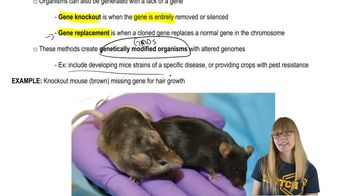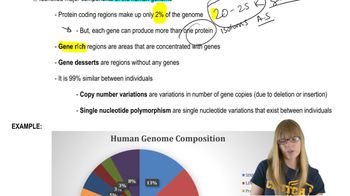Table of contents
- 1. Introduction to Genetics51m
- 2. Mendel's Laws of Inheritance3h 37m
- 3. Extensions to Mendelian Inheritance2h 41m
- 4. Genetic Mapping and Linkage2h 28m
- 5. Genetics of Bacteria and Viruses1h 21m
- 6. Chromosomal Variation1h 48m
- 7. DNA and Chromosome Structure56m
- 8. DNA Replication1h 10m
- 9. Mitosis and Meiosis1h 34m
- 10. Transcription1h 0m
- 11. Translation58m
- 12. Gene Regulation in Prokaryotes1h 19m
- 13. Gene Regulation in Eukaryotes44m
- 14. Genetic Control of Development44m
- 15. Genomes and Genomics1h 50m
- 16. Transposable Elements47m
- 17. Mutation, Repair, and Recombination1h 6m
- 18. Molecular Genetic Tools19m
- 19. Cancer Genetics29m
- 20. Quantitative Genetics1h 26m
- 21. Population Genetics50m
- 22. Evolutionary Genetics29m
15. Genomes and Genomics
Genomics and Human Medicine
Problem 25a
Textbook Question
A number of mouse models for human cystic fibrosis (CF) exist. Each of these mouse strains is transgenic and bears a different specific CFTR gene mutation. The mutations are the same as those seen in several varieties of human CF. These transgenic CF mice are being used to study the range of different phenotypes that characterize CF in humans. They are also used as models to test potential CF drugs. Unfortunately, most transgenic mouse CF strains do not show one of the most characteristic symptoms of human CF, that of lung congestion. Can you think of a reason why mouse CF strains do not display this symptom of human CF?
 Verified step by step guidance
Verified step by step guidance1
<Understand the role of the CFTR gene: The CFTR gene encodes a protein that functions as a channel for chloride ions across cell membranes. Mutations in this gene can disrupt ion transport, leading to the symptoms of cystic fibrosis (CF).>
<Consider species-specific differences: Mice and humans have different respiratory systems. The size, structure, and function of the lungs in mice differ from those in humans, which may affect how CF symptoms manifest.>
<Evaluate mucus production: In humans, CF is characterized by thick, sticky mucus in the lungs, leading to congestion. Mice may produce mucus differently, or their mucus may not be as thick or sticky, preventing lung congestion.>
<Examine immune response: The immune response to CFTR mutations may differ between species. Mice might have a different inflammatory response, which could influence the development of lung congestion.>
<Consider environmental factors: The laboratory environment where mice are kept might not replicate the conditions that exacerbate lung congestion in humans, such as exposure to certain pathogens or pollutants.>
Recommended similar problem, with video answer:
 Verified Solution
Verified SolutionThis video solution was recommended by our tutors as helpful for the problem above
Video duration:
1mPlay a video:
Was this helpful?
Key Concepts
Here are the essential concepts you must grasp in order to answer the question correctly.
CFTR Gene and Cystic Fibrosis
The CFTR gene encodes a protein that functions as a chloride channel in epithelial cells. Mutations in this gene lead to cystic fibrosis (CF), a genetic disorder characterized by thick mucus production, particularly affecting the lungs and digestive system. Understanding the specific mutations in the CFTR gene is crucial for studying the disease's phenotypes and developing targeted therapies.
Recommended video:
Guided course

Transgenic Organisms and Gene Therapy
Transgenic Mouse Models
Transgenic mouse models are genetically modified mice that carry specific genes or mutations to study human diseases. These models allow researchers to observe the effects of particular genetic alterations in a controlled environment. However, differences in physiology between mice and humans can lead to variations in disease manifestation, which may explain why certain symptoms, like lung congestion in CF, are not observed in mouse models.
Recommended video:
Guided course

Transgenic Organisms and Gene Therapy
Phenotypic Variation
Phenotypic variation refers to the observable traits and characteristics of an organism, which can be influenced by genetic and environmental factors. In the context of cystic fibrosis, different mutations in the CFTR gene can lead to a range of symptoms and severity of the disease. The lack of lung congestion in mouse models may highlight the complexity of phenotypic expression and the limitations of using these models to fully replicate human disease.
Recommended video:
Guided course

Genomic Variation

 6:51m
6:51mWatch next
Master Human Genome Composition with a bite sized video explanation from Kylia Goodner
Start learningRelated Videos
Related Practice


